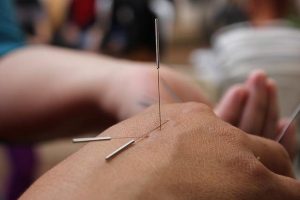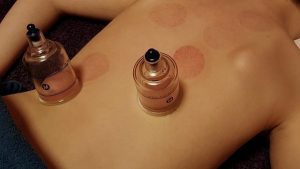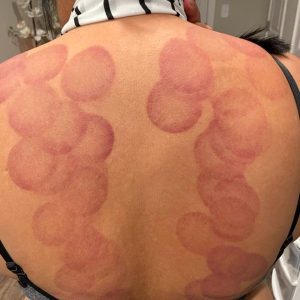You know, I don’t believe I have ever met anyone that looked forward to their seasonal flu shot or a Tdap booster – and as someone who went through multiple IVF cycles, meaning hundreds of needles, I can confidently say the injections were not my favorite part of fertility treatments.
So why do I continue scheduling monthly appointments with my acupuncturist? Even with the involvement of yet another myriad of needles throughout the year, the benefits of acupuncture and traditional Chinese medicine have far outweighed the teensy poke I experience at every session, and has become an easy way I practice self-care. I always look forward to meeting my board-certified and licensed professional, and will always encourage others to give it a try.

What is acupuncture?
According to the National Certification Commission for Acupuncture and Oriental Medicine (NCCAOM), acupuncture is “the stimulation of specific points on the body by insertion of very fine, sterile, stainless steel needles to elicit a predictable physiological response”.
Thanks to organizations including NCCAOM, newcomers to this path of treatment can read certified research on the advantages of traditional Chinese medicine and why after thousands of years, the practice of acupuncture is still so commonly used throughout the world.
In the U.S., a licensed and certified acupuncturist will assess and diagnose your health concerns and needs similar to going through intake at your doctor’s office (you know, “What brings you in today?”).
Unlike your doctor, however, your acupuncturist considers your answers while beginning to create a treatment plan that includes where those needles are gonna go within the next few minutes (if acupuncture is part of your treatment plan, that is, your acupuncturist may not use acupuncture on you).
As mentioned, acupuncture needles are extremely thin and sterile and are inserted by way of a barely-noticeable pinch that will stay in throughout your session. These are inserted in specific areas your acupuncturist has determined will address your concerns and have been shown to increase blood flow to the area, as well as to increase internal production of endorphins – the body’s natural painkillers.
My experience … not always needles!

For me, my appointments generally last anywhere from 40-60 minutes, depending on what areas I want treated. For example: my last appointment was about 60 minutes long including intake, which doesn’t take as long anymore as a returning patient.
I wanted to address my back pain and sore shoulders (my body is still adjusting to carrying a growing toddler who can’t walk yet!). After intake, my acupuncturist determined the best treatment would require me to lay on my stomach, but asked if I was comfortable with this approach. This is why I love acupuncture; treatment can still happen effectively even if I were laying on my back. This really came in handy while I was pregnant and couldn’t lay on my stomach at all. Because there are so many points on the body that can be triggered to provide relief, a skilled acupuncturist will work with however your body is positioned.
Sometimes, acupuncture isn’t even part of my treatment for the day. I have also tried acupressure (a form of massage) and cupping (an intimidating treatment at first, but not at all unlike a hard-pressured massage – just with a sign-off mark), and I have even tried electroacupuncture – small electric stimulation to certain inserted needles. However, my favorite needle-less treatment has to be cupping.

To give a brief description to the process, cupping involves small rounded glasses that are quick-warmed inside with fire, and immediately applied to the skin to create suction. This promotes immediate blood flow and circulation to that area, usually in order to provide muscle tension and pain relief. The cups can be manipulated and moved, but this is the more painful part of the process – and yes, the suction does often leave bruising, though it’s not painful once removed. I have really found that it has given long-term relief to some of my more stubborn aches.
But when it comes to acupuncture itself, after getting into a comfortable position, a quick small swipe of an alcohol swab goes on the skin where the needle sites will be. Before I know it, I have multiple needles in (because I barely felt the microscopic poke of it) and I’m taking a very well-deserved rest and the tension in my body begins to relax.
So what does acupuncture treat?
The World Health Organization recognizes acupuncture as effective for many ailments including the common cold, anxiety and stress, muscle pains, stomach issues such as ulcers, headaches and migraines, menstrual cramps, and the very reason I explored treatment in the first place: infertility.
I began acupuncture after my first egg retrieval after some encouragement from a friend. Though I was never against trying traditional Chinese medicine, or even hesitant, I didn’t consider it, simply because, I didn’t think of it. I am so thankful I gave it a shot. I truly believe acupuncture helped me through my infertility – if not by helping treat my infertility itself, then by helping me find some relief in the anxiety of IVF and healing my physical and mental aches. Either way, I have found a lifelong method of treatment and self-care!
How to find an acupuncturist near you
Although my acupuncturist was recommended to me, I still dived into research on what makes this professional a master. I love that my practitioner is certified and licensed, meaning she has gone to school to graduate with a master’s degree in traditional Chinese medicine after extensive hours in biomedicine courses, and has taken a national board exam to become a licensed acupuncturist.
NCCAOM provides a Practitioner Search Engine/Directory on its website if you’d like to search for someone certified and licensed as well.
I would also recommend for you to conduct your own research – ask your trusted medical professionals their recommendations or thoughts on acupuncture and traditional Chinese medicine, check in with your local mom groups and friends, consider what benefits you might experience by giving it a try, and get to a level of comfort where you feel that acupuncture is worth exploring. I certainly do.
















